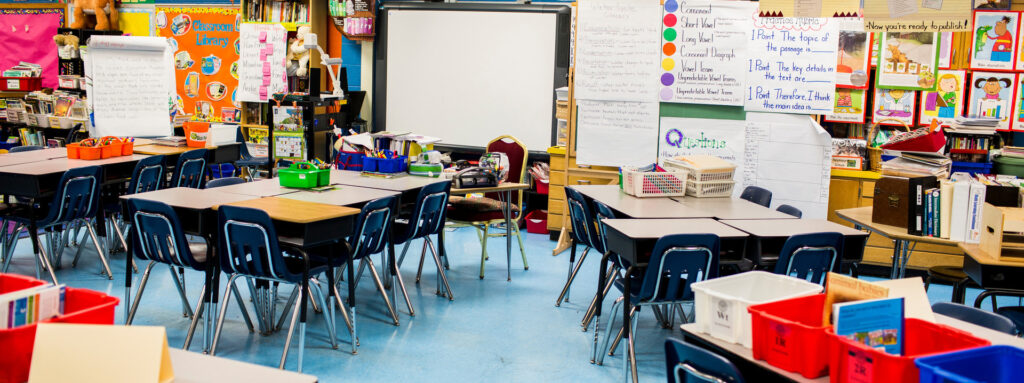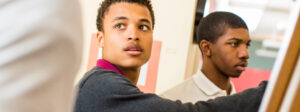A few months ago, we sat down with Dr. César A. Cruz, one of TNTP’s 2016 Bridge Fellows, to discuss his path to the fellowship, and his work empowering students who are too often written off as “thugs” or criminals. Since we last spoke, César has embarked on a learning expedition around the country, visiting schools and community organizations that are doing excellent work meeting the needs of these kids. We connected with him to see what he’s learned so far.
You’ve spent the last several years in academia. What inspired you to take a step back from formal research, and instead educate yourself through experience?
One of the blessings of the Bridge Fellowship is that it’s given me the opportunity to spend an entire year focusing on two questions: one, how can teacher prep programs better equip educators to meet the needs of young men of color, and two, how can schools and community programs more effectively support that work? There is no better way to learn about what the ideal learning community might look like than to listen to the young men themselves.
But there’s an important caveat to my research. I'm specifically focusing on boys and young men who have been expelled from school, who have been locked up or are currently locked up, and who are disengaged in the classroom. This is not a blanket look at all boys and young men of color. These could be youth that have been labeled “at risk”; if I must use labeling language, I might say they're “at risk of starting a revolution,” because these are young people that, in my experience, have been very resilient, but have been dealt multiple strikes, and are figuring out creative and resourceful ways to survive and thrive.
I really believe that when these young people find themselves, find their agency, they truly can change the world.
Can you tell us more about what you mean by “at risk of starting a revolution”?
I’m talking about the Malcolm Littles who are becoming the Malcolm Xs. Malcolm Little was a young man who was running numbers, smoking weed, breaking into houses, got involved in human trafficking, and then found himself in prison. While he was incarcerated, one of his main teachers—a culturally responsive one—who was also incarcerated, saw in him a light and helped him find himself. And in the end, with support from a great teacher, Malcolm Little found himself and became Malcolm X, the great human rights leader.
When I’m working with these students, I think, “That's Malcolm X in front of me. I have an opportunity to teach Harriet Tubman. I'm sitting in front of Rosa Parks. This is César Chávez.” I think of young people that way, and I treat them that way.
As educators, we get the opportunity to impact, and be impacted by, human life for 180 days out of the year, for eight hours a day, and that is one of the most sacred callings in our society. So, if a student curses at me, I ask myself, “Am I looking at someone who just told me off, or am I looking at a revolutionary revolting?” Maybe it’s his way of fighting back. I consider it my job to channel that energy toward positive social change.
You’ve been on a “learning tour” for the past few months. What are you looking for in the schools and communities you’re visiting?
To kick off my trip, I spent a week in New York City visiting three different community spaces and two schools. I also have plans to visit schools in four more cities. Looking at these five cities, I’m specifically interested in what's working, why it’s working, and what the young people have to say about what's working.
Is there anything you've been surprised to hear?
I think first we need to understand how we, as educators, see the world, and what we think we’re going to find when we talk to young people, so I try to make sure to examine my own lens. For example, as I’ve said, I've been looking to talk to youth who have been labeled as on the margins, so already I'm singling out certain kids, and I might be making assumptions about who's on the margins and who's not.
To some extent the “ahas” have come from the sorts of things these young men are thinking about. They're thinking about love. They're thinking about the sciences. They're thinking about community. They're thinking about rich and complex topics, and having rich and complex conversations. Mind you, these are 14 to 18-year-old boys. It’s not that I didn't expect these conversations to happen, but I can’t say I anticipated the level at which they’re happening.
I’m asking simple things like, “If you were the principal at your school, what would you do?” or “What kind of school would you create if you had all the money in the world?” The kinds of answers they're delivering are blowing me away, but maybe it's because I’ve still been carrying a lingering deficit mindset.
So, rather than suggest that what I’ve seen on my learning expedition might be surprising, I’ll instead pose a question to my fellow educators: How do you see kids on the margins? What do you think you're going to hear from them? If you expect brilliance from these students, then their brilliance isn’t surprising at all.
Is there a specific student you met who has made an impact on you?
There’s one young man, who I’ll call Devon, who comes to mind. Before the school’s morning assembly, the principal approached me and said, “You know, I appreciate that you’re focusing on young people involved in gangs. I want to point out this one young man who is heavily involved, Devon. If you get a chance, talk to him.”
Later in the day, I had a chance to sit down with Devon and ten of his classmates. What I saw, when I got the chance to meet with him, was that this young man wanted so much to heal, to process, and to speak. He sometimes dominated the conversation, but he did so in such a powerful and eloquent way. He had so much brilliance to share.
When I asked them to describe their dream school, Devon was the first to answer. He told us that at his dream school, autistic kids would be welcomed, and special education and regular education would be taught in the same classroom.
After Devon finished, two other young men spoke about wanting a space to cry at school, a place to “open up and let go of the tough guy mask.” Another told me he wanted to create a test to gauge empathy and emotional intelligence, saying, “If you look at people like Hitler, what good did school do for him if he used his education for evil?” Another said that his dream school would be open 24-hours a day, so that students would have a safe place to sleep when things got tough at home. Another said he wanted a school where all students would have a chance to go to study in another country, learning without walls or borders. Another advocated for the creation of a class that would teach kids “how to love.”
The session concluded with a conversation about hope, and in particular, BIB, the students’ acronym for Black is Beautiful. One spoke about how he puts on a suit and tie to go to his internship at a national news organization, and that he is one of very few Black people in the building. He said that what people notice most about him is his skin color, but that that motivates him to strive harder, and change the reality that very few people in positions of power look like him.
Finally, near the end of the session, one of the students asserted, “No one in the world has exceeded the limit of thinking. Humans only use a small percentage of our brains, so imagine, when we create the types of schools where we can use more of our brain, it’ll lead to the end of hatred, for sure.” Indeed, imagine that!
So, here’s the thing: initially, Devon’s principal and I both thought of him as “a gang member.” I even went into the school asking to speak to students “on the margins,” so of course, that’s how the principal identified these students. Talking to Devon and his peers, I saw that we were all doing them a disservice by thinking this way.
I was trained by a phenomenal poetry teacher, June Jordan, who said, “Whenever you speak, you want to have maximum impact with minimum words.” The words we choose to describe young people shape how we—and others—see those young people.
In many spaces, Devon might be kicked out, might become a statistic, might be labeled a thug. He did open up about some of the things he does out on the streets, but that's not all he opened up about. He and his peers also shared some real wisdom that will inform the way I teach, and the way I teach others to teach.
What if we could shine a spotlight on all the kids like Devon? What if we could shine a light on the students we see with the facade of the baggy pants or criminal records, kids we've labeled as “on the margins”? What might we learn from what they have to say?





